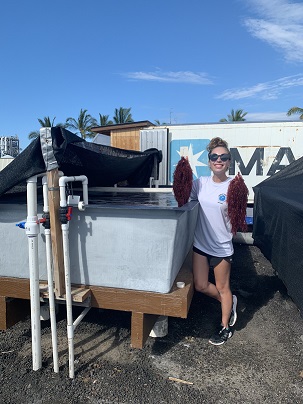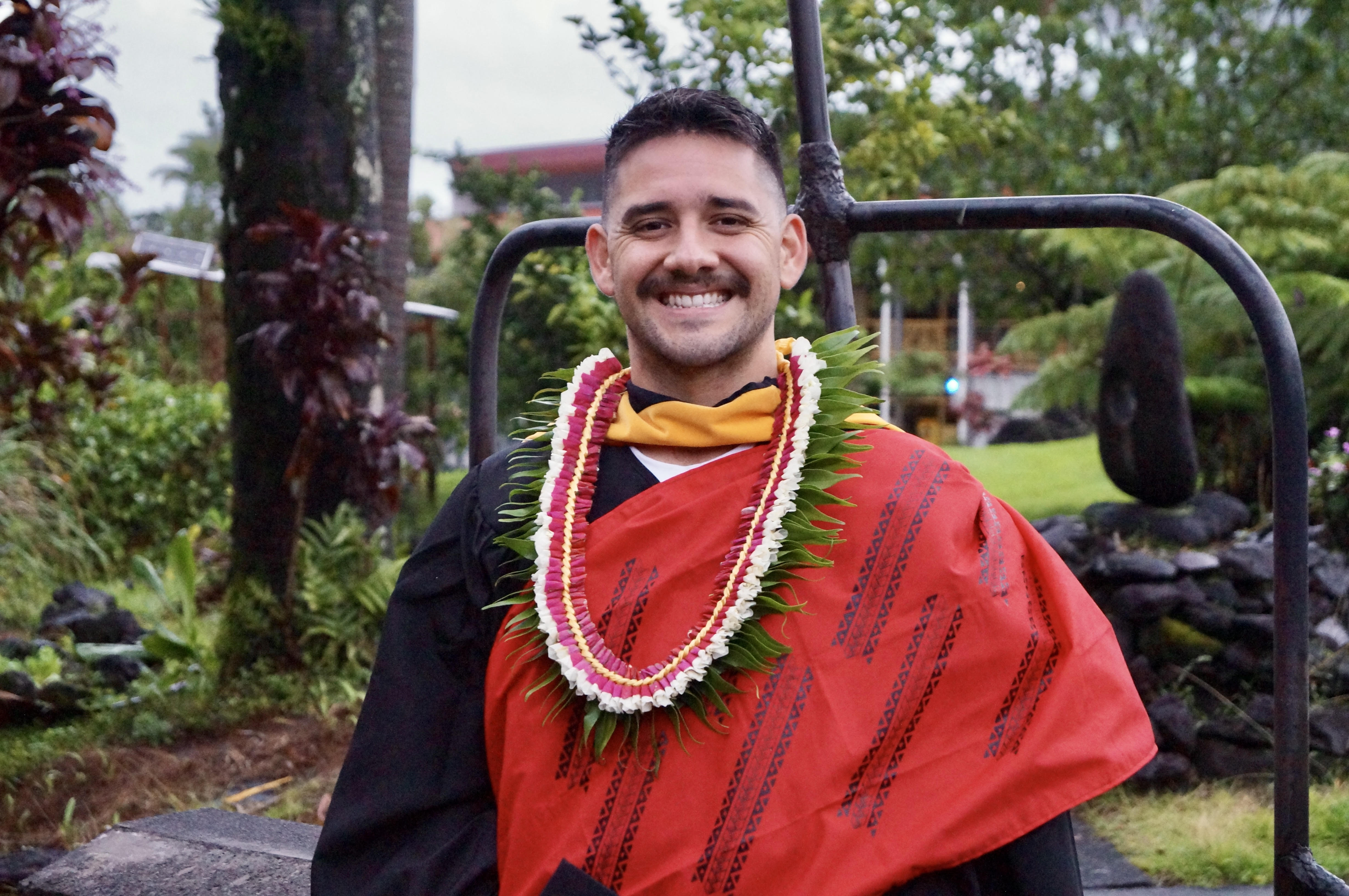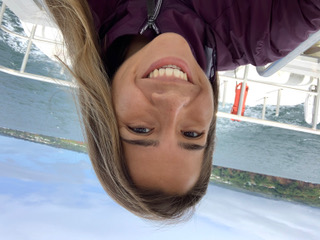2019 Intern Cohort
On this page:
Jordyn Anderson
 Jordyn (Fall 2019 cohort) is from Seattle, Washington and her internship is with OceanEra. A fun fact about her internship is that one of the species of algae grown at OceanEra is Halymenia, and all of the biomass (over 100kg at one point) at the facility, comes from a single plant that was collected from the wild! At OceanEra, she is learning what it takes to be a technician at an aquaculture facility, with her favorite organisms, native Hawaiian algae. In addition to cleaning, caring for the plants, and maintaining their tanks, she is also learning the "behind the tank" skills, such as plumbing water and air lines, and small construction projects to make pieces that fit OceanEra's exact needs. Jordyn's favorite part of her internship is working with Keelee Martin (OceanEra mentor), who shares her love for native species of algae. One of the most challenging things Jordyn does on a typical day is culling the plants that are not thriving. While it makes her sad to dispose of them, it is always for the better of the main biomass in the tank!
Jordyn (Fall 2019 cohort) is from Seattle, Washington and her internship is with OceanEra. A fun fact about her internship is that one of the species of algae grown at OceanEra is Halymenia, and all of the biomass (over 100kg at one point) at the facility, comes from a single plant that was collected from the wild! At OceanEra, she is learning what it takes to be a technician at an aquaculture facility, with her favorite organisms, native Hawaiian algae. In addition to cleaning, caring for the plants, and maintaining their tanks, she is also learning the "behind the tank" skills, such as plumbing water and air lines, and small construction projects to make pieces that fit OceanEra's exact needs. Jordyn's favorite part of her internship is working with Keelee Martin (OceanEra mentor), who shares her love for native species of algae. One of the most challenging things Jordyn does on a typical day is culling the plants that are not thriving. While it makes her sad to dispose of them, it is always for the better of the main biomass in the tank!
Geoffrey Grimmett
Geoffrey (Fall 2019 cohort) was raised in Alexandria, Virginia but currently resides in Mililani on the island of Oahu. Geoffrey's internship is with The Hawaiʻi State Department of Health's Hazard Evaluation and Emergency Response (HEER). Fun fact about HEER: Geoffrey believes "the campus is haunted, there's a ton of old buildings, an abandoned pool, and an old graveyard on site". During his internship he was tasked with obtaining and mapping the residential addresses of children who received a blood lead test between the years of 2015 and 2019. He pulled environmental pollution data from the state's databases and mapped these as environmental exposure sites in GIS. Finally, he used all of these data to assess how environmental factors may be contributing to lead exposure in Hawaiʻi. Geoffrey's favorite part of his internship was going to work every day with his mentors, getting to learn from them, and getting to know them. In addition, he thoroughly enjoyed participating in the site investigation that HEER conducted for one Oahu family. The most challenging aspect of his internship was familiarizing with the organization (HEER) and getting used to working remotely during the early parts of COVID-19.
Sean Kirkpatrick

Sean (Fall 2019 cohort) is originally from California and his internship is with the Institute of Pacific Islands Forestry (IPIF). The scientists at IPIF lead the development and communication of knowledge and technology required to sustain, enhance, and restore the function, health, and productivity of ecological, hydrological, and atmospheric systems, and associated benefits to society. The focus of Sean's internship is bio-security and the disease Rapid ʻŌhiʻa Death and the Ceratocystis fungi that cause it. Moreover, he is tasked with quantifying the translocation risk of viable spores and how effective the suggested sanitation are at reducing that risk. When asking Sean about his favorite part of his internship, he responded, "Knowing that my efforts will have a long lasting impact on the native landscape". The most challenging aspect of his internship: "Some of the diagnostic methods that are employed in the lab are extremely meticulous requiring patience and a lot of practice to become proficient at".
Kawehi Lopez
Kawehi (Fall 2019 cohort) is from Panaʻewa, Hilo and her internship is with Big Island Invasive Species Committee (BIISC). Fun fact about her agency: employees of the Big Island Invasive Species Committee are referred to as BIISC-uits. Kawehi is currently working on a digital communication plan to help BIISC transition and expand its educational components to an online platform. She is also working on an annual report to share with local legislators and other local elected officials. In addition to this work, she plans on attending higher level planning meetings and learning more about the grant writing and reporting process. Kawehi is truly an all-star for BIISC! Kawehi mentions her favorite part of the internship is producing a video that depicts a typical day in the field with her rapid ʻōhiʻa death field crew, which will be shown at this year's ʻŌhiʻa Love Fest in November 2020. Not unlike others, the most challenging part of her internship was the influence of COVID-19, as her original research project was on the barriers and benefits of homeowner control of invasive little fire ants.
Sarah J. Norrbom
 Sarah (Fall 2019 cohort) is from the beautiful Oregon Coast and her professional internship is with Tillamook Estuaries Partnership (TEP) and Friends of Netarts Bay Watershed, Estuary, Beach, and Sea (WEBS). TEP works to protect and restore the health of Tillamook County's watershed, this includes Tillamook Bay, which is listed as one of the 28 estuaries of national significance. Sarah's internship projects consist of: mapping invasive plant species in Tillamook County for both TEP and WEBS, collecting seeds and completing a seed collection story-map, and monitoring water quality of Sand Lake Estuary. The majority of Sarah's professional internship is creating and compiling GIS information to identify future restoration and research needs in Tillamook County. She enjoys working outside on a variety of different projects from collecting data on water quality, to surveying invasive plant species, and collecting seeds or materials for plant propagation. Sarah says, "it is amazing to have the opportunity to work with all the wonderful people at TEP and WEBS while exploring all the beautiful places on the Oregon Coast". The most challenging part of her professional internship was finding a new professional internship agency and adapting her work around COVID restrictions.
Sarah (Fall 2019 cohort) is from the beautiful Oregon Coast and her professional internship is with Tillamook Estuaries Partnership (TEP) and Friends of Netarts Bay Watershed, Estuary, Beach, and Sea (WEBS). TEP works to protect and restore the health of Tillamook County's watershed, this includes Tillamook Bay, which is listed as one of the 28 estuaries of national significance. Sarah's internship projects consist of: mapping invasive plant species in Tillamook County for both TEP and WEBS, collecting seeds and completing a seed collection story-map, and monitoring water quality of Sand Lake Estuary. The majority of Sarah's professional internship is creating and compiling GIS information to identify future restoration and research needs in Tillamook County. She enjoys working outside on a variety of different projects from collecting data on water quality, to surveying invasive plant species, and collecting seeds or materials for plant propagation. Sarah says, "it is amazing to have the opportunity to work with all the wonderful people at TEP and WEBS while exploring all the beautiful places on the Oregon Coast". The most challenging part of her professional internship was finding a new professional internship agency and adapting her work around COVID restrictions.
Michael Stone
 Michael (Fall 2019 cohort) is originally from Northern California and his professional internship is with Hawaiʻi Wildlife Fund. Since 2003, Hawaiʻi Wildlife Fund has pulled more than 285 tons of plastic pollution from the shores of Hawaiʻi Island alone. In the summer of 2020 Michael participated in beach cleanups, marine debris surveys, and net removals on the island of Hawaiʻi. Additionally, Michael had an opportunity to see the Hoʻōla One, a large machine that collects microplastics from sand, aid in the clean-up of microplastic-ridden beaches. During these outings he also collected data on brand name products that washed ashore Kamilo beach in Southeast Hawaiʻi. A rewarding aspect of his professional internship was submitting testimony on Senate Bill 52 “For an Ordinance Amending Chapter 20.26, Maui County Code, Relating To the Sale and Use of Plastic Disposable Foodware" which ended up passing unanimously on the board 9-0. Michael mentions the most challenging part of this experience was adapting the professional internship to COVID-19's strict social guidelines.
Michael (Fall 2019 cohort) is originally from Northern California and his professional internship is with Hawaiʻi Wildlife Fund. Since 2003, Hawaiʻi Wildlife Fund has pulled more than 285 tons of plastic pollution from the shores of Hawaiʻi Island alone. In the summer of 2020 Michael participated in beach cleanups, marine debris surveys, and net removals on the island of Hawaiʻi. Additionally, Michael had an opportunity to see the Hoʻōla One, a large machine that collects microplastics from sand, aid in the clean-up of microplastic-ridden beaches. During these outings he also collected data on brand name products that washed ashore Kamilo beach in Southeast Hawaiʻi. A rewarding aspect of his professional internship was submitting testimony on Senate Bill 52 “For an Ordinance Amending Chapter 20.26, Maui County Code, Relating To the Sale and Use of Plastic Disposable Foodware" which ended up passing unanimously on the board 9-0. Michael mentions the most challenging part of this experience was adapting the professional internship to COVID-19's strict social guidelines.
Sebastian A.W. Maʻa
 Sebastian (Fall 2019 cohort) is from the beautiful Big Island of Hawaiʻi and his professional internship is with County of Hawaiʻi Real Property Tax Division. Did you know that the County of Hawaiʻi Real Property Tax Division is expanding their native forest dedication program to include a functional forest and a successional forest land-use dedication which enables landowners to receive reduced property tax rates for native forest restoration and preservation? Sebastian was integral in this program, developing documents that support the implementation of Bill 178 as it will streamline the process for the county, helping them to effectively and efficiently evaluate forestry management plans while also providing landowners with the tools they need to maximize the success of their native forest restoration endeavors. His favorite part of his internship was working together with a variety of ecological professionals such as an environmental lawyer and the County of Hawaiʻi Real Property Tax Division, on Bill 178 which will help to effectively preserve Hawaiʻi's native forests through island-wide native forest restoration. Sebastian mentions the most challenging aspect of his professional internship included creating a management plan and guidelines template that landowners can use to help them qualify for one of the three native forest land-use dedications.
Sebastian (Fall 2019 cohort) is from the beautiful Big Island of Hawaiʻi and his professional internship is with County of Hawaiʻi Real Property Tax Division. Did you know that the County of Hawaiʻi Real Property Tax Division is expanding their native forest dedication program to include a functional forest and a successional forest land-use dedication which enables landowners to receive reduced property tax rates for native forest restoration and preservation? Sebastian was integral in this program, developing documents that support the implementation of Bill 178 as it will streamline the process for the county, helping them to effectively and efficiently evaluate forestry management plans while also providing landowners with the tools they need to maximize the success of their native forest restoration endeavors. His favorite part of his internship was working together with a variety of ecological professionals such as an environmental lawyer and the County of Hawaiʻi Real Property Tax Division, on Bill 178 which will help to effectively preserve Hawaiʻi's native forests through island-wide native forest restoration. Sebastian mentions the most challenging aspect of his professional internship included creating a management plan and guidelines template that landowners can use to help them qualify for one of the three native forest land-use dedications.
Carmelita Villalobos
 Carmelita (Fall 2019 cohort) is from Chicago and her internship is with the Marine Mammal Center/Ke Kai Ola. Fun fact: there are only 1,400 Hawaiian Monk Seals in the world, all of which are located in the Hawaiian Islands. Three hundred of those seals are found on the main Hawaiian Islands. For her internship she is tasked with surveying Big Island beaches for monk seals, along with taking pictures of the 10 resident monk seals to create a catalog of their identifiers so they are easily recognized by staff and volunteers. Carmelita's internship also contains a community outreach role where she will be teaching the proper way to observe monk seals without disturbing or harming them to ensure that the population stays healthy. She describes her favorite part of working with Ke Kai Ola is "getting to survey the beaches in Kona for monk seals. Learning to identify monk seals in a field lava rock is a skill that takes a lot of practice! Finding a seal and knowing what to look for to tell them apart from the others is always challenging and exciting!". In the same vein, the most challenging part of her internship is learning to identify the 10 Hawaiian Monk Seals seen on Big Island since the markers and tags are hard to see, especially at a distance!
Carmelita (Fall 2019 cohort) is from Chicago and her internship is with the Marine Mammal Center/Ke Kai Ola. Fun fact: there are only 1,400 Hawaiian Monk Seals in the world, all of which are located in the Hawaiian Islands. Three hundred of those seals are found on the main Hawaiian Islands. For her internship she is tasked with surveying Big Island beaches for monk seals, along with taking pictures of the 10 resident monk seals to create a catalog of their identifiers so they are easily recognized by staff and volunteers. Carmelita's internship also contains a community outreach role where she will be teaching the proper way to observe monk seals without disturbing or harming them to ensure that the population stays healthy. She describes her favorite part of working with Ke Kai Ola is "getting to survey the beaches in Kona for monk seals. Learning to identify monk seals in a field lava rock is a skill that takes a lot of practice! Finding a seal and knowing what to look for to tell them apart from the others is always challenging and exciting!". In the same vein, the most challenging part of her internship is learning to identify the 10 Hawaiian Monk Seals seen on Big Island since the markers and tags are hard to see, especially at a distance!
